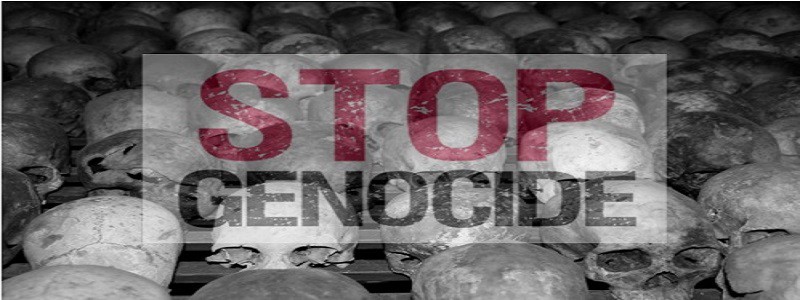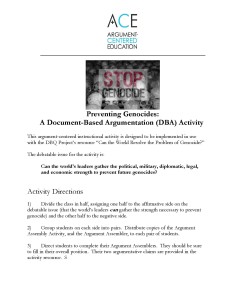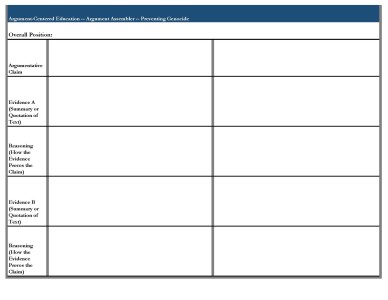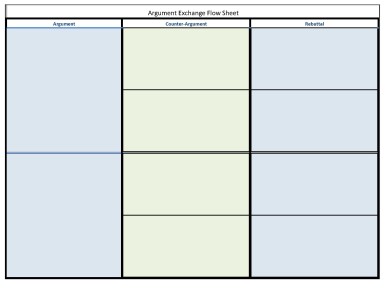
Document-Based Argumentation and International Response to Genocide
Document-based questions (DBQs) have become an increasingly popular way to teach history and social science in American middle and high schools. The activity starts with a debatable issue, then students are given a set of short excerpts from primary documents related to the issue. Students use the thinking tools of historians as they build arguments to support a position on the issue. Sounds — and is — pretty argument-based.
Argument-Centered Education’s variation on document-based questions — which we call document-based argumentation (DBA) — brings to the fore the argument construction process (making it explicit that that’s what historians, and therefore history students, are doing in academic situations like these), brings argumentation into a consistent system for teaching argument, and (crucially) introducing a component that requires refutation (the locus of critical thinking in argument) and debatificaction.
Recently, we worked with a partner school’s world studies teachers to build a document-based argumentation activity on the topic of stopping future genocides. Specifically, the debatable issue for this activity is:
Can the world’s leaders gather the political, military, diplomatic, legal, and economic strength to prevent future genocides?
The activity is a relatively brief one, utilizing an argument assembler for which students are given argumentative claims and a portion of the evidence and reasoning they should use to build their arguments. The full lesson description is contained in the overview resource.
 The document excerpts for the activity come from this publicly available DBQ on the international community’s response to genocides.
The document excerpts for the activity come from this publicly available DBQ on the international community’s response to genocides.
Since this is quick-argumentation version of a DBA, students are provided with model argumentative claims, and a portion of the evidence and reasoning culled through historians’ thinking from the document excerpts. Students use these provided pieces to assemble their arguments for the position on the debatable issue that they are arguing for — either that the international community can muster the political, military, diplomatic, legal, and economic strength to prevent future genocides, or that it cannot.
 This document-based argumentation project culminates with each side of the bifurcated classroom making the best arguments for its position, then (again, crucially) counter-arguing against the other side’s arguments. This is followed by refutation of the other side’s counter-arguments. And it ends with a brief, closing argument evaluation — weighing and synthesizing the evidence and reasoning put forward by both sides in a manner that makes it clear what the truest position is on the debatable issue. As is true of the Argument-Centered Education approach generally, this process of argumentation should be tracked.
This document-based argumentation project culminates with each side of the bifurcated classroom making the best arguments for its position, then (again, crucially) counter-arguing against the other side’s arguments. This is followed by refutation of the other side’s counter-arguments. And it ends with a brief, closing argument evaluation — weighing and synthesizing the evidence and reasoning put forward by both sides in a manner that makes it clear what the truest position is on the debatable issue. As is true of the Argument-Centered Education approach generally, this process of argumentation should be tracked.
 All of this adds up to debatified version of document-based learning: a DBA on the international response to genocide.
All of this adds up to debatified version of document-based learning: a DBA on the international response to genocide.

